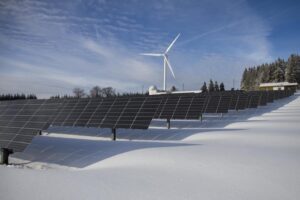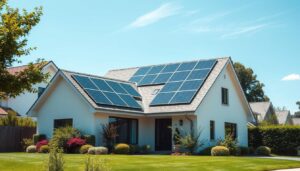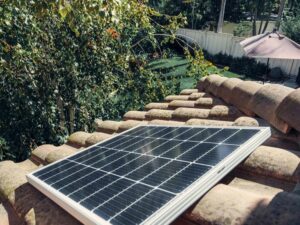The energy provided by the sun for just one hour could meet global energy needs for an entire year. This staggering statistic highlights the sheer potential of solar power as a renewable and eco-friendly energy source. As the solar power industry continues to advance, driven by innovations in quantum physics and nanotechnology, more Australian households and businesses are exploring the integration of solar energy systems. However, the decision to transition to solar power involves weighing the pros and cons to determine if it’s a sustainable option for your specific needs.
Key Takeaways
- Solar power is a renewable and clean energy source that can reduce your carbon footprint.
- Solar panels can provide significant cost savings by slashing your electricity bills.
- Installing solar panels can increase your property value by up to $15,000.
- Solar energy systems generally require low maintenance and come with long warranties.
- The initial cost of a solar setup can be substantial, but it can pay for itself within 6-10 years.
Benefits of Solar Energy
Renewable and Clean Energy Source
Solar energy is a remarkable renewable energy source that holds immense potential to transform our energy landscape. Harnessing the power of the sun, solar panels contain photovoltaic (PV) cells made of semiconductor materials that absorb photons and convert them into usable electricity. This process not only decreases the use of non-renewable resources but also benefits the community by reducing the environmental impact of solar energy generation.
The growth of solar technology has been substantial, with the introduction of various solar panel rebates driving increased demand in the market. Solar energy is a renewable and clean energy source that is available every day, ensuring long-term sustainability with an estimated lifespan of at least 5 billion years. This renewable nature makes solar power a renewable energy source that can help us minimize our reliance on fossil fuels and reduce our carbon footprint.
“Solar energy is a remarkable renewable energy source that holds immense potential to transform our energy landscape.”
The solar power industry continues to experience consistent technological advancements, with the potential to double or triple the efficiency of solar panels. This ongoing innovation further solidifies solar energy’s position as a renewable energy source that can benefit the community and reduce the environmental impact of solar energy generation.
| Solar Energy Capacity Growth | Annual Electricity Generation |
|---|---|
| Global solar energy capacity has grown exponentially, from just 7.7 gigawatts (GW) in 2007 to over 707 GW in 2020, a 92-fold increase in just 13 years. | Solar energy generation has also increased significantly, from 15.8 terawatt-hours (TWh) in 2007 to 727 TWh in 2020, a 46-fold increase. |
Reduced Electricity Bills
Switching to solar energy can help most consumers power their homes more affordably. As power prices continue to rise, solar offers a reliable way to reduce your power bill and achieve long-term savings. While the initial investment in a solar system represents a significant expense, the costs are typically offset by the savings on your electric bill.
In fact, homeowners investing in a solar power system can expect an average return on investment of about 10%. Moreover, you can claim a 30% tax credit on your income taxes for the cost of installing a solar system. With solar panels designed to last 20 to 30 years without major updates, the long-term savings can be substantial.
Many states also allow homeowners with surplus electricity generated by their solar panels to sell that energy back to the grid, further offsetting the cost of their system. Solar power systems typically reduce utility costs for homeowners compared to traditional utilities, making it a smart choice in the face of rising power prices.
“Most homeowners can save $25,000 to over $110,000 over 25 years with solar energy.”
The upfront cost of a residential solar power system in the United States ranges from $10,000 to $18,000 on average, but the payback period is typically around 8 years. After that, you can enjoy the benefits of reduced electricity bills for the remaining lifespan of your solar panels, which can be 25 to 35 years.
Increased Property Value
Investing in solar panels can significantly boost the value of your home. According to the National Renewable Energy Laboratory, every dollar a solar panel saves you on your electrical bills increases the value of your home by $20. Homes with solar panels also tend to sell for 4% higher than those without them.
The financial benefits of solar energy extend beyond just lower electricity bills. When you install solar panels, you’re making a long-term investment that can pay off when it’s time to sell your home. Buyers are often willing to pay a premium for homes with solar power, as they know they’ll be saving money on utility costs in the long run.
| Statistic | Value |
|---|---|
| Increase in property value per watt of solar | $4 |
| Increase in resale value for a standard 5kW system | Up to $20,000 |
| Percentage of responders willing to pay up to $10,000 more for a home with solar | 57% |
| Percentage increase in property value for homes with solar | Variable |
In addition, homes with solar panels tend to sell 20% faster than those without, according to industry studies. This further highlights the desirability of solar panels increase home value and the appeal they hold for homebuyers.
The increased home resale value of solar-equipped homes is just one of the many benefits of investing in renewable energy. By harnessing the power of the sun, homeowners can not only save on their electricity bills but also enhance the long-term value of their most significant asset: their home.
Low Maintenance Costs
One of the key advantages of investing in a solar energy system is its low maintenance requirements. Once installed, a well-designed solar panel system can operate efficiently for decades with minimal upkeep. This makes solar energy a low-maintenance and cost-effective option that benefits the community by reducing electricity bills and environmental impact.
Solar panels are renowned for their durability, with most manufacturers offering performance guarantees of 25 years or more. The absence of moving parts in a solar system means there is little risk of mechanical failure, and the systems are designed to withstand harsh weather conditions. Regular cleaning, typically required once or twice a year, is often the extent of the maintenance needed to keep solar panels operating at peak efficiency.
- The average household can save about $1,500 per year on electric bills when they install solar panels.
- Solar panels can save homeowners around $0.16 per kilowatt-hour on electricity costs.
- Solar energy costs have reduced significantly over time, with the average-sized solar system cost being less than $25,000 in 2024.
While the initial investment for a solar system can be substantial, the long-term savings and low maintenance requirements make it a wise financial decision that benefits the community by reducing environmental impact. As solar technology continues to advance, the costs are expected to decrease further, making this renewable energy source an increasingly attractive option for homeowners and businesses alike.
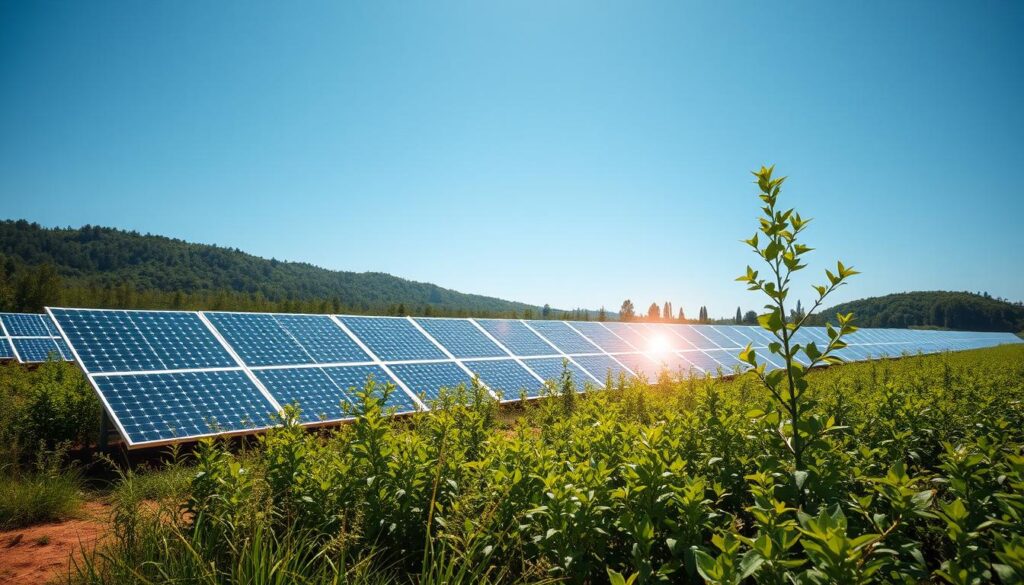
Versatile and Diverse Applications
Solar energy is incredibly versatile, offering far-reaching applications beyond just powering our homes and businesses. It can provide off-grid power in remote areas where access to the traditional electricity grid is impractical or impossible. From satellites and boats to isolated communities, solar energy is a game-changer, enabling energy independence and access to essential services.
Off-Grid Power and Water Distillation
One of the most exciting uses of solar energy is in water distillation. In regions with limited access to clean water, solar-powered distillation systems can effectively remove salts and impurities, transforming brackish or saline water into potable drinking water. This is a vital application for communities facing water scarcity.
Solar-powered pumps are another innovative use, ideal for irrigation purposes in remote, off-grid areas. These systems have lower operating and maintenance costs compared to traditional fuel-powered pumps, making them a sustainable choice for agricultural communities.
- Solar dryers facilitate the drying of crops, vegetables, and fruits by eliminating moisture content, extending the growing season and reducing post-harvest losses.
- Flat plate box type solar cookers harness short-wavelength solar radiation to provide an efficient, eco-friendly means of cooking.
- Concentrated solar power (CSP) systems use mirrors to concentrate sunlight onto receivers, generating electricity through heat conversion.
The versatility of solar energy continues to expand, with new applications emerging that leverage its clean, renewable nature to address a wide range of challenges, from energy independence to water scarcity. As the technology advances, the potential for solar to transform lives and communities around the world only continues to grow.
What are the pros and cons of solar energy?
As the world shifts towards renewable energy sources, solar power has emerged as a popular choice for many homeowners and businesses. The pros and cons of solar energy are worth examining to understand its potential impact on your energy needs and the environment.
Solar Power Advantages
- Renewable and Clean Energy Source: Solar energy is a renewable resource, unlike fossil fuels, and it produces no harmful emissions, making it an environmentally friendly option.
- Reduced Electricity Bills: Once the initial investment is made, solar panels can significantly reduce your electricity costs, providing long-term savings.
- Increased Property Value: Homes with solar panels often have a higher resale value, making solar energy a wise investment.
- Low Maintenance Costs: Solar panels require minimal maintenance, with most systems lasting for decades with little upkeep.
Solar Power Disadvantages
- High Initial Costs: The upfront cost of installing a solar energy system can be a significant barrier for some homeowners and businesses.
- Weather and Storage Limitations: Solar panels are dependent on sunlight, and their performance can be affected by weather conditions. Energy storage solutions can be expensive.
- Space Requirements: Solar panels require a significant amount of roof or land space, which may not be feasible for all properties.
- Environmental Concerns: The manufacturing and disposal of solar panels can have an environmental impact, which must be considered.
While the pros and cons of solar energy should be carefully evaluated, the long-term benefits of this renewable energy source make it an attractive option for many. As technology continues to improve and costs decrease, solar power may become an increasingly viable choice for a growing number of consumers.
“Solar energy is the fastest-growing renewable energy source, with global solar capacity increasing by 22% in 2020 despite the COVID-19 pandemic.”
| Solar Power Advantages | Solar Power Disadvantages |
|---|---|
| Renewable and Clean Energy Source | High Initial Costs |
| Reduced Electricity Bills | Weather and Storage Limitations |
| Increased Property Value | Space Requirements |
| Low Maintenance Costs | Environmental Concerns |
Challenges of Solar Energy
While solar energy has experienced significant growth and declining costs in recent years, it still faces some notable challenges. The primary hurdles include the high upfront costs, installation complexity, and space constraints.
High Initial Costs and Installation Complexity
Despite decreases in the cost of solar panels over the past decade, a complete solar installation still requires significant investment. On average, a consumer in Australia can expect to pay around $18,000 on a complete solar setup for a home before accounting for any incentives and the federal solar tax credit. Additionally, although most of the components in installing solar panels are relatively simple, if you’re not comfortable working on a roof or dealing with electrical work, the installation process can be complicated. Tying the panel wiring into the home’s electrical system can be a complex task for the average DIYer and is best left to professional installers.
- The global solar capacity has increased by over 18% in 2020.
- Solar power accounted for 43% of all new electricity-generating capacity added in the U.S. in 2020.
- Solar energy prices have dropped by 88% over the last decade, but the upfront costs remain high.
One of the primary challenges of solar energy is the high upfront costs associated with the installation. While the long-term savings can offset these initial expenses, the installation can be difficult for those without experience, particularly when it comes to integrating the solar panels with the home’s electrical system. Additionally, space constraints may limit the feasibility of solar for some properties, further complicating the adoption process.
“The solar industry employs over 230,000 workers in the United States, showing a 44% growth in employment over the last five years.”
Weather and Storage Limitations
While solar energy is a renewable and clean source of power, it faces significant challenges when it comes to weather dependence and energy storage limitations. Unlike traditional fossil fuels, solar energy is inherently sunlight dependent, meaning that without consistent sunlight, the system cannot produce electricity. This can pose a problem for consumers in areas with less-than-ideal levels of sun exposure or weather dependent conditions.
To mitigate this issue, many homeowners and businesses are turning to solar energy storage solutions, such as batteries. However, these storage systems can be solar energy storage is expensive, with a single lead-acid battery costing between $200 and $800, and a residential lithium-ion solar system costing $7,000 to $14,000. The high initial investment can be a significant barrier to widespread solar energy adoption.
Additionally, the intermittent nature of sunlight and the need for reliable energy storage pose ongoing challenges for maximizing the potential of solar power. Continued technological advancements and innovative solutions are necessary to overcome these practical obstacles and unlock the full benefits of solar energy.
| Advantage | Disadvantage |
|---|---|
| Renewable and clean energy source | Weather dependent |
| Low operating costs | Expensive energy storage solutions |
| Job creation in renewable energy sector | Intermittent nature of sunlight |
To address these challenges, ongoing investment in solar technology research and development, as well as supportive public policies, will be crucial for the continued growth and widespread adoption of solar power in Australia and beyond.
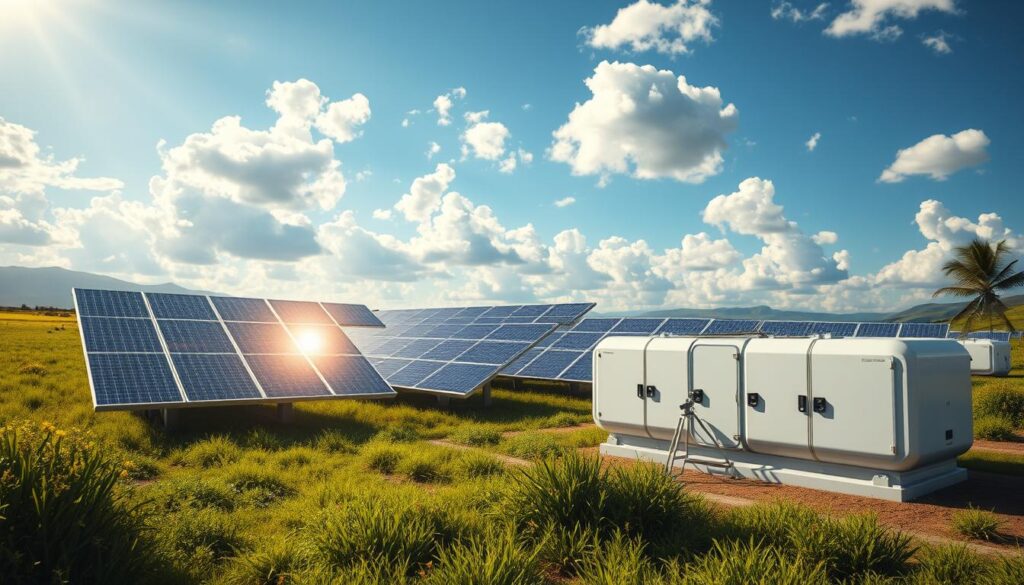
“Addressing the intermittent nature of sunlight is crucial for maximizing the potential of solar energy.”
Space Requirements and Environmental Concerns
While solar energy offers numerous benefits, there are some considerations around space requirements and environmental impact that are worth exploring. Solar panels and their associated wiring take up a significant amount of space, and finding enough suitable land with adequate exposure can be a challenge, particularly in densely populated residential areas.
The production of solar technology also has environmental downsides. The mining of raw materials and the manufacturing of solar panels generate a considerable amount of greenhouse gas emissions. Additionally, the disposal or recycling of solar panels at the end of their lifespan can be problematic, as options may be limited in some regions.
- Utility-scale solar energy facilities typically have a generation capacity of 20 MW or greater, requiring vast areas of land.
- The construction and operation of solar facilities can lead to soil compaction, altered drainage, increased runoff, and erosion, affecting the local environment.
- Solar power facilities may also create visual impacts due to their large size and reflective surfaces, potentially affecting the surrounding landscape.
While the environmental benefits of solar energy are substantial, it is essential to consider the space constraints and environmental impact of manufacturing and disposal/recycling options that may be limited. Ongoing research and innovation in solar technology can help address these challenges and ensure a more sustainable energy future.
“Solar power is the third largest source of renewable energy globally, behind hydropower and wind, and it is the fastest-growing source.”
Conclusion
When considering the transition to solar energy, it’s important to weigh both the pros and cons. The advantages of solar power include its renewable and clean nature, the potential to reduce electricity bills, increased property value, low maintenance costs, versatility, and long-term savings. However, the disadvantages of solar energy include the high upfront costs, dependence on sunlight, expensive energy storage, space requirements, and environmental impact of manufacturing.
Ultimately, the decision to go solar depends on your specific circumstances and priorities, but this guide has provided a comprehensive overview of the solar power advantages and disadvantages to help you make an informed decision for your home or business in Australia. With careful consideration of the costs, benefits, and limitations, you can determine if solar energy is the right choice to power your lifestyle and contribute to a more sustainable future.
The transition to solar power is a significant investment, but one that can pay dividends in the long run through reduced electricity bills, increased property value, and a cleaner, more sustainable energy source. By weighing the pros and cons of solar energy, you can make an informed decision that aligns with your personal and financial goals, ultimately contributing to a brighter, more sustainable future for your community and the planet.

